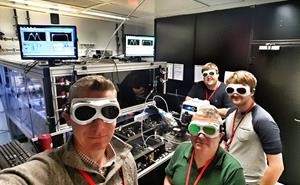Taking Mechanistic Snapshots of Important Synthetic Reactions
In a landmark study, researchers from the Department of Chemistry have gained new mechanistic insights into C-H activation, a vital chemical reaction process.
The activation of a C-H bond at a metal centre, and its subsequent functionalization, is undeniably one of the most important breakthroughs in organic and synthetic chemistry in the last 15 years. It provides access to important chemical building blocks for the agrochemical, materials and pharmaceutical sectors. Even though scientists have figured out how to carry out many complex C-H activation processes, there remain mysteries around the mechanistic steps that take place.
In research published in Journal of the American Chemical Society, Professor Ian Fairlamb and Dr Jason Lynam, working with scientists from Syngenta and the STFC Central Laser Facility used fast laser methods to understand the deprotonation step, which allows C−H bond activation at a manganese(I) centre. The activation of a C-H bond by formal deprotonation is extremely difficult to observe because of how rapidly the process takes place.

Front to back: Ian Fairlamb, Jason Lynam, Jonathan Eastwood and Anders Hammarback working on the Time-Resolved Infrared Spectrometer at the STFC Central Laser Facility.
Computational modelling was used to map out intermediate steps and likely transition state structures. However, this approach requires experimental validation to give a true and clear picture of the complete reaction pathway. Therefore, the team devised a direct strategy to observe the microscopic reverse of the deprotonation (activation) step – the protonation of a photochemically-activated complex, namely [Mn(ppy)(CO)4] (ppy = 2-phenylpyridyl).
The observation and quantification of the microscopic reverse of the deprotonation processes enabled direct translation to the forward process involved in C-H bond activation. Time-resolved infrared spectroscopy (TRIR) was used to take snapshots of the catalytic reaction over picosecond to millisecond time scale, allowing experimental observation of the computationally-predicted pathway.
The team was therefore able to provide direct and compelling evidence for the key intermediates and processes predicted within the reaction mechanism for the first time. This gave rise to unprecedented levels of detail that would have been missed using alternative approaches.
The research is published in Journal of the American Chemical Society 2021, 143, 1356-1364.